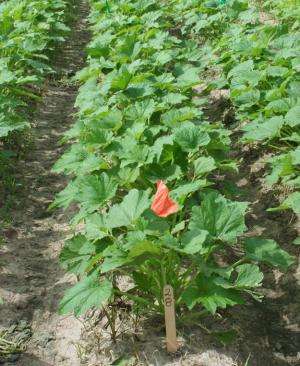Impact of pelargonic acid for weed control in yellow squash

Growers who produce squash for market are increasingly interested in using more natural herbicides that are also effective in providing season-long weed control, but the options for controlling annual broadleaf weeds in summer squash are currently limited. The authors of a new study say that both organic and conventional producers will benefit from the identification of natural herbicides that effectively provide postemergent weed control. Charles Webber III, Merritt Taylor, and James Shrefler conducted a research study published in HortTechnology to determine the impact of pelargonic acid—a fatty acid that occurs naturally in plants and animals and is found in many foods—on weed control efficacy, crop injury, and squash yields of yellow squash.
"Although pelargonic acid is not listed as a 'certified organic' herbicide, it is seen as a more natural type herbicide for use in sustainable crop production," explained Webber. The researchers designed experiments in which pelargonic acid (PA) was applied to 'Enterprise' yellow squash (unshielded postdirected) at 5-, 10-, and 15-lb/acre. The experiments included an untreated weedy control and an untreated weed-free control. Pelargonic acid was applied in mid-July, and then reapplied eight days later.
Results of the experiments revealed that maximum smooth crabgrass control, broadleaf weed control, and yellow nutsedge control occurred with the 15-lb/acre PA treatment at 9 days after initial spray treatment and 1 day after the sequential treatment. Pelargonic acid at 15-lb/acre provided equal or slightly greater smooth crabgrass and broadleaf control compared with the 10-lb/acre application, and consistently greater control than the 5-lb/acre rate and the weedy control. Pelargonic acid was less effective at controlling yellow nutsedge than smooth crabgrass and broadleaf weeds.
Analyses showed that increasing the PA application rate increased the crop injury rating at 1 and 3 days after each application; maximum squash injury occurred for each application rate at 9 days after treatment. Yield analysis found that the 10-lb/acre PA treatment produced the highest squash yields and fruit number compared with either the 5- or 15-lb/acre rates, and yields and fruit number equivalent to the hand-weeded, weed-free treatment.
"This research determined that a sequential postdirected application of pelargonic acid at 10-lb/acre in 40-gal/acre can consistently produce satisfactory weed control with low crop injury to produce weed-free equivalent squash yields," Webber said.
More information: The complete study and abstract are available on the ASHS HortTechnology electronic journal web site: horttech.ashspublications.org/ … ent/24/1/25.abstract
Provided by American Society for Horticultural Science

















